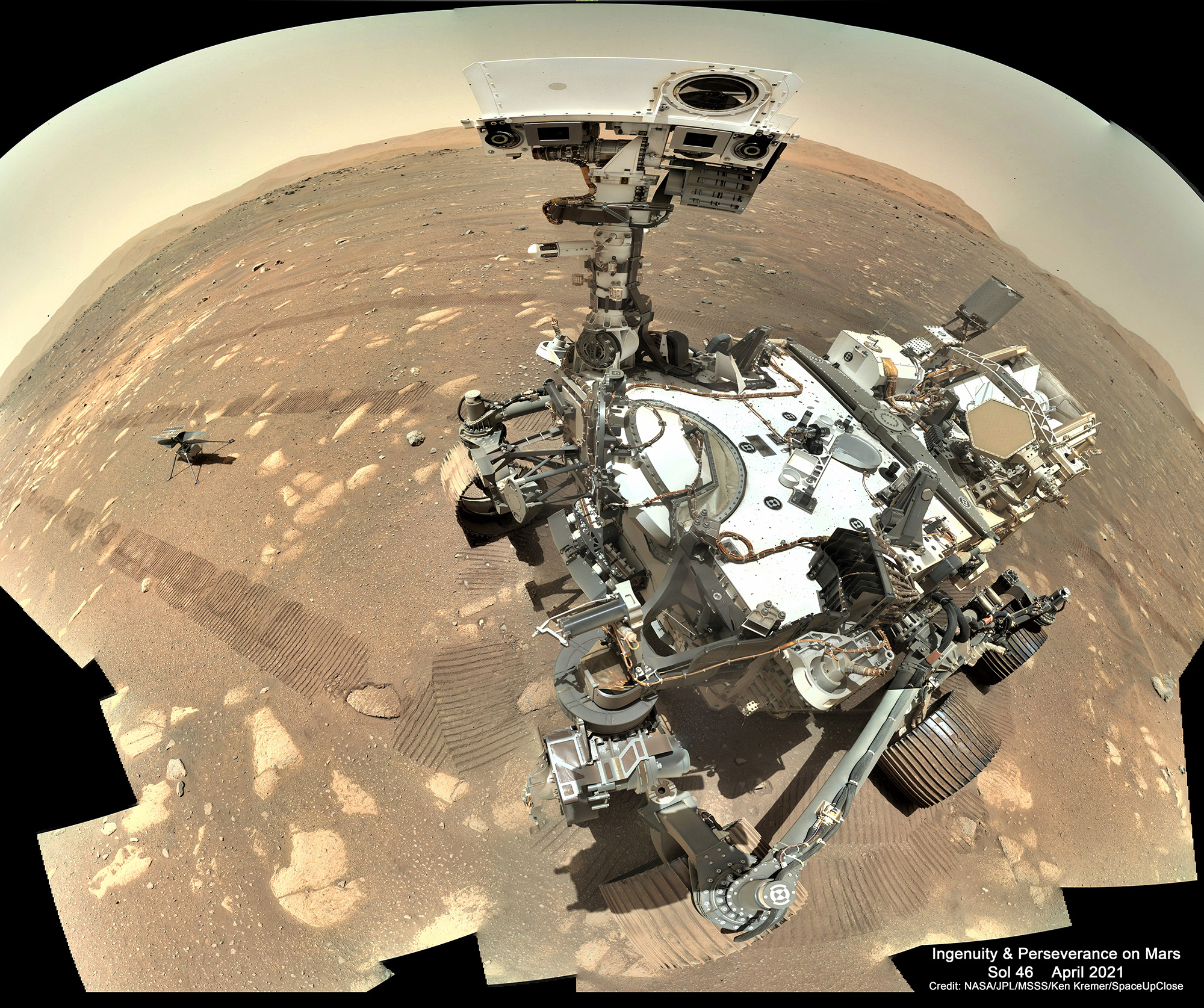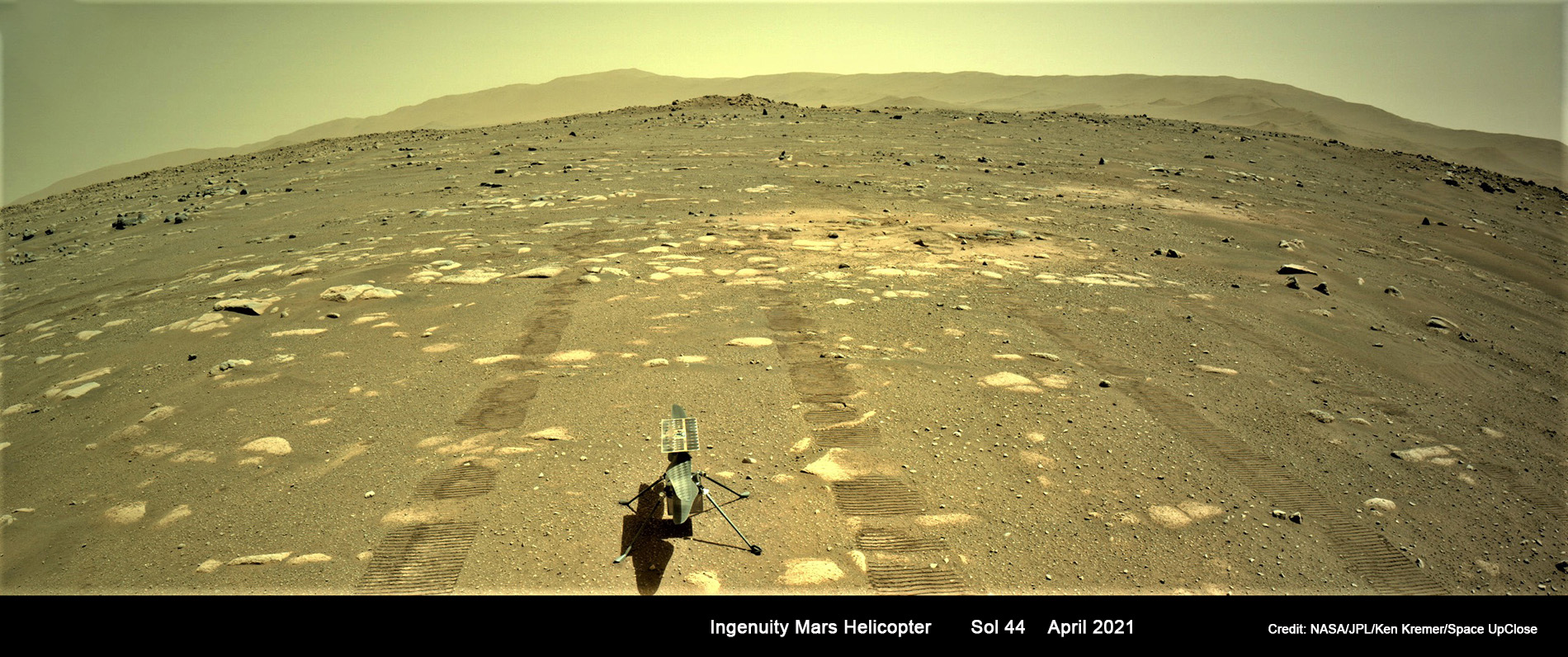
For SpaceUpClose.com & RocketSTEM
CAPE CANAVERAL, FL – NASA’s Ingenuity chopper completed its extremely challenging 4th test flight on Friday, April 30, by again flying faster and farther than ever before – far surpassing all prelaunch objectives during testing on Earth while making history as humanity’s first aircraft to fly beyond Earth. And because of that and the fact that the Perseverance rover mothership is in an extremely interesting area for science and rock sample drilling, NASA leadership decided to give the ‘Ginny’ experimental helicopter team an new extended mission by assuming an operational support role working in tandem with ‘Percy’ for the time being.
“NASA’s Ingenuity Mars Helicopter has a new mission. Having proven that powered, controlled flight is possible on the Red Planet, the Ingenuity experiment will soon embark on a new operations demonstration phase, exploring how aerial scouting and other functions could benefit future exploration of Mars and other worlds,” NASA officials announced at a media briefing.
“Ingenuity successfully completed its fourth flight today, and we couldn’t be happier,’ wrote MiMi Aung, Ingenuity Mars Helicopter Project Manager at NASA’s Jet Propulsion Laboratory in a blog post.
Ginny took flight at 10:49 a.m. EDT (7:49 a.m. PDT, 1449 GMT, or 12:33 local Mars time) on April 30, or Sol 69 of the mission, and climbed to the same altitude of 16 feet (5 meters) as in tests #2 and #3.
Then it flew south for a round trip totaling 872-feet (266-meters) and approximately 436 feet (133 meters) one way each that also lasted a total time in the thin Martian air of 117 seconds, before again safely returning to and softly touching down at ‘Wright Brothers Field.’
Thats over 2.5 times more than the 328 feet (100 meters) roundtrip accomplished in Flight #3 and 50% more than previous flight time of 80 seconds.
Thus this 4th flight success couldn’t come at a time – coupled with the mission extension for an extended duration flight campaign lasting at least another month beyond the ‘Month of Ingenuity’ that NASA had previously allowed and limited the helicopter team to for the exhilarating test flight campaign to demonstrate the first controlled flight on another celestial body.
“That’s another set of records for the helicopter, even compared to the spectacular third flight,” Aung noted.

Furthermore Ingenuity simultaneously also captured more breathtaking in-flight aerial black and white and color image of the Red Planet than ever before ! – including dramatic background views of the Martian landscape at Jezero Crater and the Perseverance rovers tracks crisscrossing the Red Planet’s ancient surface further demonstrating the paradigm shifting impact of the history making flights of the experimental Martian Chopper.
“Success! #MarsHelicopter completed its 4th flight, going farther & faster than ever before. It also took more photos as it flew over the Martian surface. We expect those images will come down in a later data downlink, but @NASAPersevere‘s Hazcam caught part of the flight,” NASA JPL tweeted.
Success 👏#MarsHelicopter completed its 4th flight, going farther & faster than ever before. It also took more photos as it flew over the Martian surface. We expect those images will come down in a later data downlink, but @NASAPersevere's Hazcam caught part of the flight. pic.twitter.com/Fx3UHu4jgv
— NASA JPL (@NASAJPL) April 30, 2021
“We also managed to capture lots of images during the flight with the color camera and with Ingenuity’s black-and-white navigation camera, which tracks surface features as it flies,” Aung wrote.
“Images from that navigation camera are typically used by Ingenuity’s flight controller and then thrown away unless we specifically tell the helicopter to store them for later use. During this flight, we saved even more images than we did on our previous flights: about 60 total during the last 164 feet (50 meters) before the helicopter returned to its landing site.”
The challenges of flying are incredible because the fully autonomous flight is carried out the extremely thin Martian atmosphere with few air molecules amounting to less than 1% as dense as Earth’s– approximately equivalent to 3 times the height of Mount Everest – and under frigid Antarctica-like conditions of minus 90 C (Minus 130 F).
Watch the team jump for joy after the results of the 4th test flight streamed back to Earth Friday:
Video Caption: Fourth Flight a Success for NASA’s Ingenuity Mars Helicopter. NASA’s Ingenuity Mars Helicopter successfully completed a fourth, more challenging flight on the Red Planet on April 30, 2021. Flight Test No. 4 aimed for a longer flight time, longer distance, and more image capturing to begin to demonstrate its ability to serve as a scout on Mars. Ingenuity climbed to an altitude of 16 feet (5 meters) before flying south and back for an 872-foot (266-meter) round trip. In total, Ingenuity was in the air for 117 seconds, another set of records for the helicopter. The fourth flight lifted off from and returned to “Wright Brothers Field” in Jezero Crater, Mars. The Ingenuity team at NASA’s Jet Propulsion Laboratory in Southern California determined that the flight was successful after receiving data from the helicopter and imagery from the Perseverance Mars rover. NASA’s Ingenuity Mars Helicopter became the first aircraft in history to make a powered, controlled flight on another planet on April 19, 2021. Perseverance touched down at Octavia E. Butler Landing with Ingenuity attached to its belly on Feb. 18, 2021. The helicopter was deployed to the surface of Jezero Crater on April 3. Credit: NASA JPL
On the upcoming 5th test flight Ingenuity will fly only one way, perhaps up to 600 meters or more, says Aung
During flight #4 the team wil use the two onboard cameras to search for a new Martian ‘air field.’
The extended mission begins after flight #5
“This new phase will begin after the helicopter completes its next two flights. The decision to add an operations demonstration is a result of the Perseverance rover being ahead of schedule with the thorough checkout of all vehicle systems since its Feb 18 landing, and its science team choosing a nearby patch of crater bed for its first detailed explorations. With the Mars Helicopter’s energy, telecommunications, and in-flight navigation systems performing beyond expectation, an opportunity arose to allow the helicopter to continue exploring its capabilities with an operations demonstration, without significantly impacting rover scheduling.”
“The Ingenuity technology demonstration has been a resounding success,” said Thomas Zurbuchen, associate administrator for NASA’s Science Mission Directorate.
“Since Ingenuity remains in excellent health, we plan to use it to benefit future aerial platforms while prioritizing and moving forward with the Perseverance rover team’s near-term science goals.”

If Ingenuity survives the 5th flight the cadence of test flights will slow down considerably from once every 3 or 4 sols to once every 2 to 3 weeks – and conclude by late August as Perseverance wraps her science campaign.
Then she moves southward to carry out her primary mission of astrobiology in search of samples that could holds clues to Martian life past or present – and are worthy of sample return to Earth via a future rover and lander and orbiter mission in collaboration with ESA.
The aerial journey continues!🚁
The #MarsHelicopter will soon embark on a new operations demonstration phase. It’ll shift its focus from proving flight is possible on Mars to demonstrating flight operations that future aerial craft could utilize. https://t.co/wH9OHZvIjv pic.twitter.com/Is50qZWhhk
— NASA JPL (@NASAJPL) April 30, 2021
‘The little rotorcraft that could’ seems unstoppable in the feats of science and engineering it accomplishes in the ‘Wright Brothers moment’ on Mars and spun up its two counter rotating carbon fiber rotor blades to over 2400 rpm
Ingenuity’s two counterrotating rotorblades are made of a lightweight carbon fiber foam core to provide lift in the thin Mars atmosphere and measure 4 feet (1.2 meters).
The flight time for the 4-pound (1.8-kg) rotorcraft is chosen to optimize energy and flight conditions and maximize the odds of success.
Perseverance has moved a safe distance away and observes the test flights from about 211 feet (64.3 meters) away at Van Zyl Overlook– see map below.
I’ve taken several turns and made about 0.17 miles (270 meters) of wheel tracks from where I started to my current spot overlooking the #MarsHelicopter.
Check in on my location any time with this interactive map: https://t.co/uPsKFhW17J pic.twitter.com/AO5LJu41f0
— NASA's Perseverance Mars Rover (@NASAPersevere) April 15, 2021
Meanwhile enjoy my version of the Sol 46 double selfie mosaic of Ginny and Percy together

Ginny and Percy (nicknames for Ingenuity and Perseverance) are seen together in my new mosaic here about 13 feet (4 meters) apart in imagery taken on April 6, 2021, on Sol 46 of the mission.
The solar powered Ingenuity helicopter is a technology demonstration experiment aimed at attempting the first flight on Mars.

The four legged Ingenuity has a mass of about 4.0 pounds (1.8 kilograms) and stands 1.6 feet or 19 inches (0.49 meters) high.
Watch Ken’s continuing reports about Mars 2020 Perseverance and Curiosity rovers, Artemis and NASA missions, SpaceX, Starlink, Commercial Crew and Starliner and Crew Dragon and onsite for live reporting of upcoming and recent SpaceX and ULA launches including Crew 1 & 2, Demo-2, ISS, X-37B, Solar Orbiter, NRO spysats and national security missions and more at the Kennedy Space Center and Cape Canaveral Space Force Station.
Stay tuned here for Ken’s continuing Earth and Planetary science and human spaceflight news: www.kenkremer.com –www.spaceupclose.com – twitter @ken_kremer – email: ken at kenkremer.com
Dr. Kremer is a research scientist and journalist based in the KSC area, active in outreach and interviewed regularly on TV and radio about space topics.
………….
Ken’s photos are for sale and he is available for lectures and outreach events
Ken has created hundreds of widely published Mars rover mosaics and lectures also about NASA’s Mars rovers
Please consider supporting Ken’s work by purchasing his photos and/or donating at Patreon:
https://www.patreon.com/kenkremer
x



